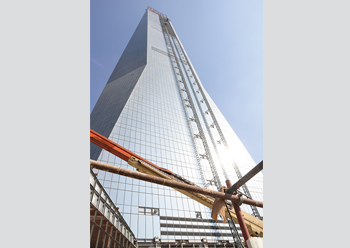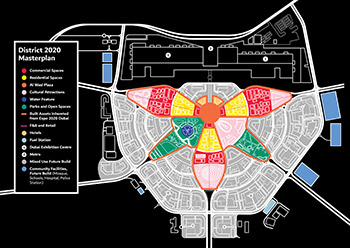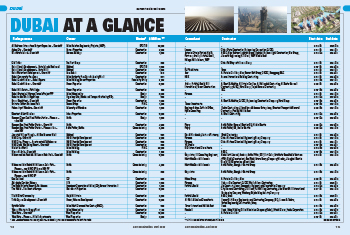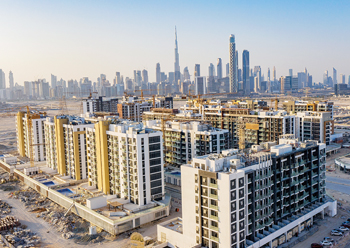
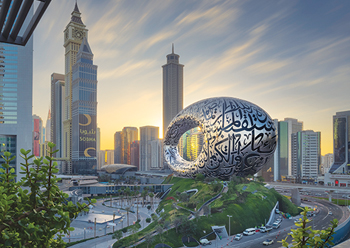 Emblazoned on the facade of the Museum of the Future are the quotes from poems written by HH Sheikh Mohammed bin Rashid Al Maktoum.
Emblazoned on the facade of the Museum of the Future are the quotes from poems written by HH Sheikh Mohammed bin Rashid Al Maktoum.
Dubai’s latest unique architectural masterpiece – the Museum of the Future – which will be peerless for quite some time, opened on a highly memorable date: 22.02.22.
Perched alongside Sheikh Zayed Road, Dubai’s main arterial highway beside the metro system and just in front of Jumeirah Emirates Towers, the futuristic torus-shaped marvel speaks volumes of the emirate’s ambitions of pushing boundaries to reach new architectural and engineering horizons and anticipate the future.
Nine years in the making, the Museum of the Future is the latest icon to be added to the list of modern global landmarks and is considered one of the most complex construction projects ever built due to its unconventional design, its sustainability goals and its awe-inspiring aesthetic.
 |
|
Natural light floods into the seven-storey structure through the windows. |
The 77-m-tall expressive landmark is a departure from the customary high-rises that dot today’s skylines – the circular building represents humanity; the green mound it sits atop represents the earth; and the elliptical void represents the unknown future.
Classified as one of the most architecturally creative structures in the world, it has been built by man and machine utilising the latest technologies.
Developed by Dubai Future Foundation, the building is a symbol for adopting innovative methods and tools that deploy futuristic technologies to reimagine the possible. This novel “living” museum tells the narrative of the future through a series of interactive exhibitions and invites people to experience the technologies and trends that will shape the future of humanity. The Museum of the Future is also set to position Dubai as a testbed for emerging technologies and an exploration base for talents, inventors and creative professionals from all over the world to unravel the challenges that will shape the future of humanity.
The pillarless structure spans an area of 30,000 sq m and comprises seven distinct floors. The main contractor on the project was BAM International – supported by BAM Ireland – which was responsible for all aspects of the construction execution and the complex design elements such as the façade and landscape mound. The structure consists of a steel framework, comprising 2,400 diagonally intersecting steel members, which was completed in November 2018. It is dressed in stainless-steel-clad glassfibre-reinforced plastic (GFRP) panels with illuminated glazed Arabic calligraphy.
 |
|
The façade is lit at night by over 14,000 m of LED lights. |
BAM says its experience in digital-led projects and the project team’s dedication to building information modelling (BIM) and digital construction have enabled a high level of integrated design and construction, perhaps impossible to achieve with traditional methods.
The architect of the project was Killa Design, while the lead engineering consultant was Buro Happold. Working with Killa Design, Buro Happold says its multidisciplinary team solved the project’s unique and complex design challenges by optimising computational tools to deliver one of the most advanced buildings in the world. Its specialist engineers developed bespoke, in-house BIM software to model and analyse numerous options for the structure to achieve the museum’s iconic torus shape.
Facade
Clad in a striking stainless-steel façade, the Museum of the Future is the only building in the world that has a surface covered entirely in calligraphy art – some 14,000 m of Arabic calligraphy designed by the Emirati artist Mattar bin Lahej. The façade is lit at night by over 14,000 m of LED lights.
Emblazoned on the exterior are the quotes from poems written by HH Sheikh Mohammed bin Rashid Al Maktoum, Vice President and Prime Minister of the UAE and the Ruler of Dubai. It features three extracts from Sheikh Mohammed’s quotes; one particularly befitting the intent of the architectural marvel is: “The future belongs to those who can imagine it, design it and execute it. It isn’t something you await, but rather create.”
 |
|
“Journey of the Pioneers” stretches over three floors and 3,000 sq m of exhibition space. |
The avant-garde façade is made of stainless steel and glass, consisting of 1,024 separate panels, each one specially created by robots and algorithms. The number of panels has its own significance, representing a basic unit of the digital information storage system of computers – a kilobyte, which is equal to 1,024 bytes. These panels cover a total surface area of 17,600 sq m.
Windows allowing natural light to flood into the seven-storey structure are designed in the form of calligraphy intricately 3D-mapped onto the building’s curved body.
Due to the building’s complex geometry and flowing calligraphy, each separate panel is unique. Each piece had to be individually precast and produced, with numerous prototypes designed and manufactured before a winning formula could be achieved, according to a spokesman of the Museum of the Future.
“Every single panel was produced using automated robotic arms. Each panel is made up of four layers and was created following a complex 16-step process. The precision and focus required to create each panel meant that only several could be produced per day.
“Parametric modelling was essential to determine the final position, size and dimensions of the Arabic lettering on each panel to ensure it offered optimum balance between natural light, solar heat gain and air-conditioning load without compromising its architectural aesthetic,” he says.
The installation for the façade was carried out in around 18 months.
Interiors
The Museum of the Future invites visitors to embark upon an expedition to the future and, through individual choices, become part of a collective effort to create a better future for all humanity.
Among the designers of the exhibition spaces, Atelier Brückner has designed the “Journey of the Pioneers” stretching over three floors and 3,000 sq m of exhibition space: every floor has been created as an immersive experience, with strikingly powerful spatial narratives focusing on a vision of the future.
The “Journey of the Pioneers” exhibition’s choreographed sequence of installations, and the sounds and scents that accompany visitors, take them away from the banalities of the everyday life and immerses them into a tangible future world where everyone has a role to play. The guiding lights and choice of materials play a significant role in the sensory experience. The space station walls, for instance, are interwoven 3D printed meshes that appear to be made from asteroid mined material, while the walls of the Heal Institute are made of sustainable rattan palm.
Landscaping
The building stands on a huge green plateau. On closer inspection, guests discover that the hill is in fact a resplendent garden comprising around 100 species of trees and plants, reflecting the country’s diverse natural ecosystem.
Featuring ghaf, sidr, palm and acacia trees, which are well adapted to local environmental conditions, the garden is equipped with a smart, automated irrigation system and supports local bee and bird populations.
With Dubai’s summer temperatures hitting close to 50 degrees Celsius, and the average rainfall being 130 mm per year, the smart irrigation system uses a sub-surface mat that delivers water directly to the root system in a targeted, efficient approach. The plateau’s steep slopes allow quick water run-off, removing the need for water-intense flood irrigation. Additionally, water collection and recycling systems are used to reduce water wastage by approximately 25 per cent.
Commenting on the project, BAM International’s Project manager Seamus O’Sullivan says: ‘Delivering the vision of Dubai Future Foundation has been a great achievement by BAM, the 1,200-plus BAM employees on site, construction partners and sub-contractors. Together we have managed to overcome the numerous challenges; this building has pushed the boundaries of what we now believe is possible. We can be proud that given these difficult circumstances our continuous attention to safety has resulted in a very strong safety performance, with no major accidents.”
The Museum of the Future has Platinum certification from Leadership in Energy and Environmental Design (LEED) – the first museum project in the Middle East to achieve this level of certification.
The low-carbon project features passive solar architecture through its extraordinary façade, as well as low-energy and low-water engineering solutions with integrated renewable capabilities. The building is powered with 4,000 megawatts of solar energy.
According to Buro Happold, the development of a 3D energy model of the building also enabled the interaction of all 12 disciplines in real time.
“This ensured sustainability was put at the heart of over 50 design decisions. As a result, we ensured a 45 per cent reduction in water use and total energy savings of 25 per cent, helping the project move towards achieving LEED Platinum status,” says a spokesman for Buro Happold.
As you gaze up at the Arabic calligraphy-wrapped façade, one line from HH Sheikh Mohammed’s quotes succinctly summarises the mission of the Museum of the Future: “We may not live for hundreds of years, but the products of our creativity can last even longer.”

















.jpg)













 (1).jpg)














































